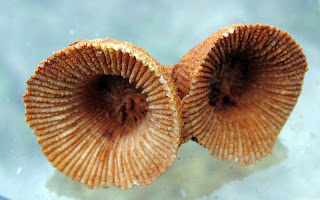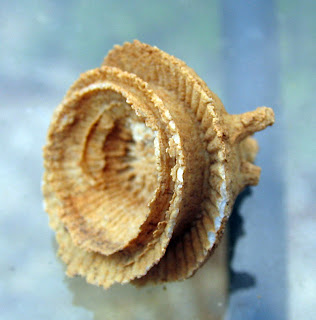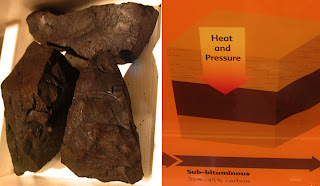Pictures are of foraminifera fossils from Starksville, Mississippi. Recovered from the Prairie Bluff Formation that contain fossils from the Upper Cretaceous Period. This first fossil might be an Anomalina sp. Images were photographed at 100x with a microscope thus need to be stacked but I am not quite ready to climb that incline. My images do not show the divots and bumps that appear on the surface of some of these fossils.
I used A Preliminary Report of the Foraminifera of Tennessee by Joseph A. Cushman (1931) as an identification guide (plates 11 and 12). It contains a number of specimens from the Upper Cretaceous. Thanks to Herb for the material. It is fossil rich!
This next fossil I cannot even guess at an identification.
This fossil might be a Globigerina sp.
Last fossil could be a Globigerinella sp.
Index Fossils of North America lists a number of Upper Cretaceous foraminifera that can be found in Mississippi: Palmula (6-14), Frondicularia (6-17), Kyphopyxa (6-18), Guttulina (7-1), Pseudopolymorphina (7-3), Gumbelitria (8-2), Gumbelina (8-1), Rentilabrella (8-4, 8-5), Bolivinoides (8-6), Pseudouvigerina (8-11), Siphogenerinoides (8-12), Buliminella (8-13), Neobulimina (8-16), Loxostoma (8-18), Lamarckina (9-2), Globigerina (11-1), and Globotruncana (11-9).
Friday, April 30, 2010
Upper Cretaceous Foraminifera
Labels:
Cretaceous,
foraminifera,
mississippi,
praire bluff formation
Thursday, April 29, 2010
Devonian Spiny Snail Fossil
This image is of a partial fossil of a spiny Platyceras dumosum (Conrad, 1840) gastropod fossil. Found in Louisville, Kentucky USA in the Devonian Period Jeffersonville Limestone. My cousin found this to add to maybe the 2-3 others he has found in the last year or so. He has prepped this one a little bit since finding it but the spines on it are impressive. Quite the little porcupine of the sea.
This image is from the book Kentucky Fossil Shells - A Monograph of the Fossil Shells of the Silurian and Devonian Rocks of Kentucky by Henry Nettelroth (1835-1887), 1889, Frankfort, Kentucky, Kentucky Geological Survey, Plate XXIII, Figure 1 of the Platyceras dumosum (Conrad, 1840).
Another picture of the specimen shown earlier but more on the intact spine side.
This image is from the book Kentucky Fossil Shells - A Monograph of the Fossil Shells of the Silurian and Devonian Rocks of Kentucky by Henry Nettelroth, 1889, Frankfort, Kentucky, Kentucky Geological Survey, Plate XXIII, Figure 2 of the Platyceras dumosum (Conrad, 1840).
He also found a negative image at a different time of another Platyceras (Conrad, 1840) again from the Jeffersonville Limestone.
This image is from the book Kentucky Fossil Shells - A Monograph of the Fossil Shells of the Silurian and Devonian Rocks of Kentucky by Henry Nettelroth (1835-1887), 1889, Frankfort, Kentucky, Kentucky Geological Survey, Plate XXIII, Figure 1 of the Platyceras dumosum (Conrad, 1840).
Another picture of the specimen shown earlier but more on the intact spine side.
This image is from the book Kentucky Fossil Shells - A Monograph of the Fossil Shells of the Silurian and Devonian Rocks of Kentucky by Henry Nettelroth, 1889, Frankfort, Kentucky, Kentucky Geological Survey, Plate XXIII, Figure 2 of the Platyceras dumosum (Conrad, 1840).
He also found a negative image at a different time of another Platyceras (Conrad, 1840) again from the Jeffersonville Limestone.
Wednesday, April 28, 2010
Eospirifer radiatus Brachiopod
This brachiopod was found in the Waldron Shale of Clark County Indiana. It is a Silurian Period brachiopod that appears to be an Eospirifer radiatus. I used the Fossils of Ohio book pages 230-231 to get this identification. The book describes it as being from the Niagaran Series which is synonymous with the Waldron Shale. The brachiopod is not fully intact with one side partial broken off revealing solid shale and calcite crystals. Its dimensions are 3.5 cm long and 3.3 cm wide. The radial lines are fine and very tightly spaced. The specimen needs to be cleaned of residual matrix.
WOW! Check out this Estonian Museum specimen database of an Eospirifer: http://sarv.gi.ee/specimen.php?id=56117 Now this is an impressive museum collections database with a sweet interface. They have 100 Kentucky specimens including three holotypes of a stromatoporoid and 98 Indiana specimens As of this writing the database has 142802 entries with 15060 images.
Different views of the same specimen found in Clark County, Indiana.
The bottom image is from page 231 of the Fossils of Ohio (Bulletin 70, Rodney M. Feldmann Editor, State of Ohio, Department of Natural Resources, Division of Geological Survey, Columbus Ohio 1986) figure 10-12 of specimen from Wenlock Limestone, Dudley, West Midlands, England.
Also check out the nice collection of Eospirifers at the Indiana State Museum on-line database.
WOW! Check out this Estonian Museum specimen database of an Eospirifer: http://sarv.gi.ee/specimen.php?id=56117 Now this is an impressive museum collections database with a sweet interface. They have 100 Kentucky specimens including three holotypes of a stromatoporoid and 98 Indiana specimens As of this writing the database has 142802 entries with 15060 images.
Different views of the same specimen found in Clark County, Indiana.
The bottom image is from page 231 of the Fossils of Ohio (Bulletin 70, Rodney M. Feldmann Editor, State of Ohio, Department of Natural Resources, Division of Geological Survey, Columbus Ohio 1986) figure 10-12 of specimen from Wenlock Limestone, Dudley, West Midlands, England.
Also check out the nice collection of Eospirifers at the Indiana State Museum on-line database.
Labels:
brachiopod,
indiana,
silurian,
waldron shale
Tuesday, April 27, 2010
Bordenia knappi
A horn coral named after William Borden whom Borden, Indiana was also named. Mr. Borden made a fortune mining silver in Colorado in the late 1800s and returned to Indiana. His geology collection became very large and after his death transferred to the Field Museum in Chicago. He might be best known for creating the Borden Institute and Museum to help educate youth in the southern Indiana area.
This horn coral is actually two clustered together but 90 degrees out of phase. It is called Bordenia knappi (Hall, 1882) and found in the Speed Member of North Vernon Limestone. It was found in Clark County, Indiana, USA and the coral existed in the Middle Devonian Period (Eifelian).
The species was named by Dr. James Hall in the 35th Annual Report of the State of New York, page 438 in 1884. It was named in honor of Professor Hall's friend long time fossil hunter Dr. James Knapp of Louisville, Kentucky, USA.
The genus Bordenia was named by long time fossil collector from New Albany, Indiana, USA George K. Greene in 1903 in Contributions to Indiana Palaeontology Volume I, page 99, plates 31 figures 4-11. He named it for William Borden who he later sold his collection to.
Labels:
borden,
devonian,
horn coral,
indiana,
north vernon limestone,
speed member
Monday, April 26, 2010
Romingeria umbellifera
Middle Devonian Period coral called Romingeria umbellifera. It was found in the Jeffsonville Limestone of Clark County, Indiana.
Enhanced image from Kentucky Fossil Corals - A Monograph of the Fossil Corals of the Silurian and Devonian Rocks of Kentucky (1885) by William J. Davis, Plate 75, Figure 12. Find on-line at KPS website of Don Chesnut web adaptation.
Enhanced image from Kentucky Fossil Corals - A Monograph of the Fossil Corals of the Silurian and Devonian Rocks of Kentucky (1885) by William J. Davis, Plate 75, Figure 12. Find on-line at KPS website of Don Chesnut web adaptation.
Labels:
coral,
devonian,
indiana,
Jeffersonville Limestone
Sunday, April 25, 2010
Fossil Prep
A while back, a friend dropped this Mississippian Period blastoid in matrix off during his trip to Louisville. He had been collecting in the Indian Springs Formation of Crawford County, Indiana. The fossil is about as big as a marble.
So these first two pictures show the blastoid in the rock matrix. I decided to extract the blastoid with the Dremel engraver. The matrix was pretty soft and flaky.
I stopped to photograph the fossil plate with the engraver lines. Matrix has broken off revealing more of the blastoid theca.
Eventually the vibration of the engraver broke the blastoid free for its rock tomb. Now I need to sand blast it to reveal the top detail. Not the white marks where I probed to see if any more matrix would break away. Decided it might damage the fossil to proceed down this path.
So these first two pictures show the blastoid in the rock matrix. I decided to extract the blastoid with the Dremel engraver. The matrix was pretty soft and flaky.
I stopped to photograph the fossil plate with the engraver lines. Matrix has broken off revealing more of the blastoid theca.
Eventually the vibration of the engraver broke the blastoid free for its rock tomb. Now I need to sand blast it to reveal the top detail. Not the white marks where I probed to see if any more matrix would break away. Decided it might damage the fossil to proceed down this path.
Labels:
blastoid,
indiana,
mississippian
Saturday, April 24, 2010
Louisville Horn Corals
Horn coral finds in Louisville, Kentucky but the identification I am not sure about the first three.
Craterophyllum horn coral found in the Jeffersonville Limestone of Louisville, Kentucky. It existed in the Devonian Period.
Craterophyllum horn coral found in the Jeffersonville Limestone of Louisville, Kentucky. It existed in the Devonian Period.
Friday, April 23, 2010
Coal Display - Louisville Science Center
My interest in coal is two fold: first it is the main source of fuel that drive the generators that provide electricity and second I find coal sometimes while looking for fossils in coral localities around Louisville. Elaborating on the second point, the area I search for coral fossils contains dumpings from an old garbage dump pre-1920s. The dump contained remains from residents coal burners and bins thus small pieces of coal were thrown away. The picture above is of one of the pieces of coal I found.
Coal is an important part of energy generation in the United States. It can be costly in terms of human lives as seen recently when 29 miners died in a explosion at the Upper Big Branch, West Virginia mine. May they rest in peace. That mine produced coal for steel mills. The environment can also suffer from improper mining techniques and unfiltered burning. Work is being done to rectify these issues.
It is a trade-off with electricity being a necessity in today's society. Hydrocarbon energy generation is one of the primary factors that drives the world economy. Coal is an important resource to Kentucky. The material is fossil remnants from the Pennsylvanian Period.
Below are images of four types of coal: lignite (brown coal), sub-bituminous, bituminous (mined in Kentucky), and anthracite. These images were produced from pictures I took of a public display at the Louisville Science Center on coal. Click the images to see larger versions.
According to the 2008 Louisville Science Center report, contributors to the World Around Us: Coal Exhibit Kiosk were International Coal Group, Kentucky Coal Association, Kentucky Department of Energy Development and Independence ($50,000 grant), Peabody Energy ($2,500 grant), and Teco Coal.
Learn more about Kentucky Coal at the education website.
The other images are from a Adobe Flash movie I created illustrating coal formation and its uses in society. I would link to the movie but I lost access to a server that could host swf files. Maybe be one day I remedy this situation.
Labels:
coal,
Kentucky,
louisville science center,
Pennsylvanian
Thursday, April 22, 2010
Cladopora Coral
A Middle Silurian Period fossil called Cladopora (old name Coenites) found in Louisville Kentucky. It is part of the Louisville Limestone. The specimen is about 10 cm in length.
This next fossil might be Syringopora from the Middle Devonian Period.
This next fossil might be Syringopora from the Middle Devonian Period.
Labels:
coral,
louisville kentucky,
silurian
Wednesday, April 21, 2010
Honeycomb Coral
Favosites coral found in Louisville, Kentucky also known as honeycomb coral. Found with Silurian Period fossils but this could be a Devonian Period fossil.
Labels:
coral,
louisville kentucky
Tuesday, April 20, 2010
Horn Coral: Aulacophyllum
Aulacophyllum horn coral found in the Jeffersonville Limestone of Clark County, Indiana. The coral existed in the Devonian Period.
Labels:
devonian,
horn coral,
indiana,
Jeffersonville Limestone
Monday, April 19, 2010
St. Clair Pennsylvania Fern Fossils
Pictures of fern fossils from St. Clair, Pennsylvania. These plants grew in the Late Carboniferous or Pennsylvanian Period and can be found in the Llewellyn Formation. Fossils compliments of Shamalama.
St. Clair is famous for the white appearance of their plant fossils which caused by aluminum silicate or pyrophyllite. This first fossil is Alethopteris.
Modern fern image to use as comparison to fossil.
St. Clair is famous for the white appearance of their plant fossils which caused by aluminum silicate or pyrophyllite. This first fossil is Alethopteris.
Modern fern image to use as comparison to fossil.
Labels:
fern,
llewellyn formation,
pennsylvania,
Pennsylvanian,
plant
Sunday, April 18, 2010
Hexagonaria Coral
This nice fossil find is from the Jeffersonville Limestone of Louisville, Kentucky. It is a Hexagonaria coral that existed in the Middle Devonian Period. For more information, see Erwin Stumm's Silurian and Devonian Corals of the Falls of the Ohio pages 43-44 and plates 38-39 (pages 128-131). The last picture is another fragment I found.
Labels:
coral,
devonian,
Jeffersonville Limestone,
louisville kentucky
Saturday, April 17, 2010
Walking With Dinosaurs
It is Thunder Over Louisville day here in Louisville Kentucky which is an event that is part of the celebration leading up to the Kentucky Derby. The day is marked by an air show and capped off with one of the largest firework displays in the United States. I usually leave in the evening before the large crowds (sometimes numbering in 500,000-750,000 people are at full force). Here is a picture of a F-16 almost hovering over the Kennedy Bridge downtown.
As in past years, I have volunteered at the Louisville Science Center for their fundraiser, ThunderBlast. This year we had a special visitor from the show Walking with Dinosaurs - The Arena Spectacular. This baby Tyrannosaurus rex replica suit is part of a show that will be visiting Louisville's Freedom Hall May 14-16, 2010. Note to self: next year bring sunblock and a hat!
I was sort of expecting some sort of animatronic creature but the suit has a person in and you can see their legs which somewhat removes the realism. But the movement, sounds and crowd interaction were good and it made for a fun event.
The T. rex would move along the crowd and kids wanted to pet it which it would them but then suddenly snap at them causing them to jump or laugh. It was interesting to watch the interactions. Unfortunately for the girl in front of me holding the hot dog and fries, it startled her into dropping her meal.
The T. rex then sort of roared (shriked, laughed, ???) after sending her lunch to the pavement. It did not go to waste, I saw somebody afterward pick it up for their dog to eat.
Baby T. rex will be making some more appearances around Louisville this month:
Sunday, April 18, 2010 at the Louisville Bats vs. Columbus Clippers game at Louisville Slugger Field, 6:05 pm
Monday, April 19, 2010 at Fourth Street Live! 11 am to 1 pm
Monday, April 19, 2010 at Kentucky Exposition Center's North Wing front patio 3:30 pm to 6 pm
The main show will be May 14-16, 2010 at Freedom Hall check www.freedomhall.org or www.dinosaurlive.com for more information. "Get your tickets before they're extinct!"
Subscribe to:
Comments (Atom)





















































